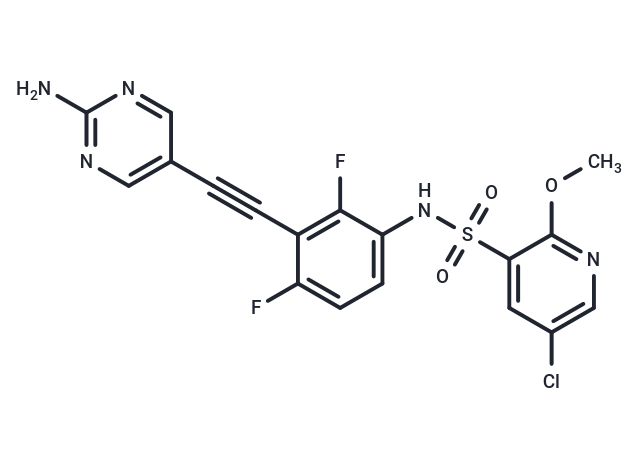Shopping Cart
Remove All Your shopping cart is currently empty
Your shopping cart is currently empty
GCN2iB is an ATP-competitive inhibitor of serine/threonine protein kinase, stress-responsive kinase (GCN2), with IC50 of 2.4 nM.

| Pack Size | Price | USA Warehouse | Global Warehouse | Quantity |
|---|---|---|---|---|
| 1 mg | $77 | In Stock | In Stock | |
| 5 mg | $178 | In Stock | In Stock | |
| 10 mg | $288 | In Stock | In Stock | |
| 25 mg | $576 | In Stock | In Stock | |
| 50 mg | $825 | In Stock | In Stock | |
| 100 mg | $1,130 | In Stock | In Stock | |
| 1 mL x 10 mM (in DMSO) | $196 | In Stock | In Stock |
| Description | GCN2iB is an ATP-competitive inhibitor of serine/threonine protein kinase, stress-responsive kinase (GCN2), with IC50 of 2.4 nM. |
| Targets&IC50 | GCN2:2.4 nM |
| In vitro | METHODS: HEK293 cells were treated with 4 nM to 4 μM Gcn2iB for 6 h in the presence or absence of Halofuginone (HF) treatment to explore the concentration-dependent effect of Gcn2iB on ISR activation. RESULTS HF treatment resulted in increased levels of p-Gcn2, p-eIF2α, and Atf4, each of which decreased with increasing concentrations of Gcn2iB; p-Gcn2 induction decreased at 62.5 nM Gcn2iB or higher, and Atf4 induction decreased at 250 nM Gcn2iB; cells treated with Gcn2iB in the absence of HF exhibited a biphasic response to the induction of p-Gcn2, p-eIF2α, and Atf4, with increases in all three ISR markers observed in the range of 10 to 100 nM Gcn2iB; above 250 nM Gcn2iB, p-Gcn2 levels decreased to below those determined with vehicle, and Atf4 levels were not significantly induced; although Gcn2iB could inhibit Gcn2 stimulation by HF treatment, lower concentrations of Gcn2iB activated Gcn2 and the ISR in the absence of external stress. [1] |
| In vivo | METHODS: HFD plus STZ-induced diabetic C57BL/6J mice were treated with intraperitoneal injection of GCN2iB (3 mg/kg) every other day for 6 weeks. At the end of the experiment, the mice were subjected to echocardiography. RESULTS After GCN2iB treatment, the fasting blood glucose level (11.18 ± 1.44 vs. 17.42 ± 2.57 mmol/L) and body weight (28.94 ± 2.05 vs. 32.54 ± 1.49 g) of type 2 diabetic mice were significantly reduced; GCN2iB treatment had no effect on heart weight. Significant effects, but increased heart weight to body weight ratio; GCN2iB treatment significantly improved cardiac systolic function and increased left ventricular (LV) ejection fraction (EF). [2] |
| Molecular Weight | 451.83 |
| Formula | C18H12ClF2N5O3S |
| Cas No. | 2183470-12-2 |
| Smiles | COc1ncc(Cl)cc1S(=O)(=O)Nc1ccc(F)c(C#Cc2cnc(N)nc2)c1F |
| Relative Density. | 1.63 g/cm3 (Predicted) |
| Color | Yellow |
| Appearance | Solid |
| Storage | Powder: -20°C for 3 years | In solvent: -80°C for 1 year | Shipping with blue ice/Shipping at ambient temperature. | |||||||||||||||||||||||||||||||||||
| Solubility Information | DMSO: 56.5 mg/mL (125.05 mM), Sonication is recommended. H2O: < 0.1 mg/mL (insoluble) | |||||||||||||||||||||||||||||||||||
| In Vivo Formulation | 10% DMSO+40% PEG300+5% Tween 80+45% Saline: 1 mg/mL (2.21 mM), Sonication is recommended. Please add the solvents sequentially, clarifying the solution as much as possible before adding the next one. Dissolve by heating and/or sonication if necessary. Working solution is recommended to be prepared and used immediately. The formulation provided above is for reference purposes only. In vivo formulations may vary and should be modified based on specific experimental conditions. | |||||||||||||||||||||||||||||||||||
Solution Preparation Table | ||||||||||||||||||||||||||||||||||||
DMSO
| ||||||||||||||||||||||||||||||||||||
| Size | Quantity | Unit Price | Amount | Operation |
|---|

Copyright © 2015-2025 TargetMol Chemicals Inc. All Rights Reserved.